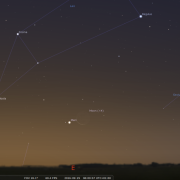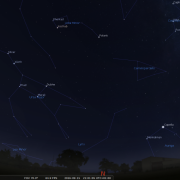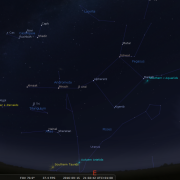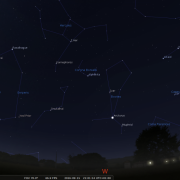Welcome to the WDAS monthly newsletter for September 2016: a digest of the month's latest contributions to our website. Below you'll find Society News, Sky Notes and In-Focus articles printed in full. There's also future events, and trailers for other articles which appear in full on the website - just a click away!
On the website you'll also be able to comment on articles, and if you'd like to play an editorial role in creating new content, just let us know!
Society News

Stone Henge in the Autumn Equinox. (Photo credit: Stonehenge Stone Circle)
The autumn equinox falls on September 22nd, the date autumn officially commences in the northern hemisphere. For the second time this year the polar axis of our planet is at right angles to the Sun and all locations receive equal hours of daylight and darkness. Having re-crossed the celestial equator the Sun is now retreating southwards, arcing ever lower above the southern horizon, its warming rays diminishing in intensity as it does so.
No, that didn’t work either... moving Regatta to later in the month, that is. Different dates, same weather.
Saturday- clouded out both afternoon and evening. We didn’t even bother to unload any equipment for these events, squally showers and really quite strong winds do not make for ‘quality’ observing. Having said that, three people do technically qualify as a ‘party’ and we did briefly spot a couple of stars in the Plough handle, so that’s star party in my book. Regatta Sunday would be better.
Sunday was a lot more encouraging, the Sun was actually shining, whoopee!

Solar Viewing at Whitby Regatta: John with his Solar Scope. This is an entry
for the Google Deep Style competition(!) See The Gallery for original photos.
So having set up on the West Cliff next to our colleague, Marcus, from Grovers Optics, we were quite eager to count all those sunspots. 0, nowt, zilch, *** all (3*’s not 4) the cupboard was bare. On closer inspection though... no... still absolutely nothing. Luckily people seemed quite happy to view a round white disk!
However all was not lost. John L arrived with his solar scope and lo and behold there was some activity on the limb, a small solar prominence and perhaps a hint of an embryonic sunspot group forming on the surface.
At least we could console ourselves that considerable interest was being shown for that night’s star party, and furthermore conditions were looking decidedly encouraging with clear skies forecast by 9pm. 9pm arrived, and so did the cloud, obviously!

No pictures from the Regatta Star Parties, but this is from the 30th July 2016 star party, in the Edvard Munch style of Mark's silent cloudy-night screams.
Many, many silent expletives later, Mark gave one of his famous cloud party talks to the assembled gathering, who had also been taken in by all those jokers at the Met office, BBC and various other forecasting bodies. The scale solar system demo went down rather well, and just as we thought erecting the scopes had been a waste of time, Lo, a lurid orange moon rose above the hotel roofs, much to everyone’s surprise and delight. Five minutes later drops of rain began to fall, heralding a hasty departure.
The first half of Monday was similar to standing under a lukewarm power shower. By the early afternoon however, skies dried and cleared. Although nothing had been planned for the Monday, Mark wandered up to the cliff to join Marcus on the Grovers stand and perhaps utilise his Celestron refractor and Kendrick solar filter to view a ‘round white disk’. After setting up and on first inspection... hang on a minute, what’s this, two sunspot groups, now where did they emerge from. Well, that’s just typical, summing up our luck this summer.
You may have noticed that Regatta Monday evening was fine and clear, 24 hours too late for us, but one hell of a backdrop for the fireworks display and a stunning gibbous moon rising out of the sea. People would have queued for ages to view that.. Aaahhhhh!
Folk Week Event
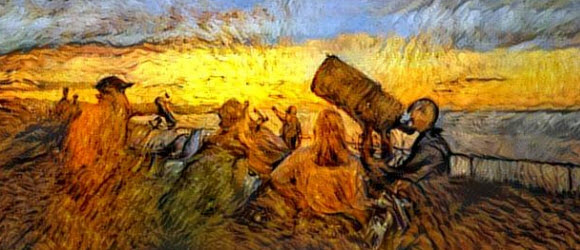
Based on an original work by Warren: twilight at the 26th August Follk Week Star Party, 20:50h.
See The Gallery for original photos.
Cloudy conditions persisted throughout much of Folkweek- at least when it mattered on an evening. However Friday 26th saw an unscheduled event on the west cliff making the most of fine, still conditions. Skies were not totally clear, but at least there were enough people around to make it worthwhile, interested, and thrilled to observe a plethora of summer deep sky wonders. It was also the first real run out for the LX 200 this year and it’s nearly September! Saturday’s event was rained off.
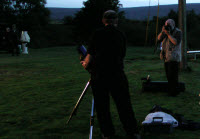 We shall be making our pilgrimage over to Westerdale to host this year’s star party on the 2nd. As usual the venue will be the village hall / car park area within the village. Start time is 20:00h for the public, but will members wishing to attend (contact Mark) be therefor 19:30-19:45pm to allow time for equipment to be set up. Anyone who has been before will know the site is reasonably dark and the natives are always friendly, and it will be nice to see our friend John. Hopefully skies will be clear, but if not plan B will be initiated.
We shall be making our pilgrimage over to Westerdale to host this year’s star party on the 2nd. As usual the venue will be the village hall / car park area within the village. Start time is 20:00h for the public, but will members wishing to attend (contact Mark) be therefor 19:30-19:45pm to allow time for equipment to be set up. Anyone who has been before will know the site is reasonably dark and the natives are always friendly, and it will be nice to see our friend John. Hopefully skies will be clear, but if not plan B will be initiated.
 Hopefully the weather will improve for one of our observing highlights, our visit to Hook’s House Farm on the 3rd, should it be cloudy however we shall try again on Sept 10th. The Moon will only be a few days old on the 3rd, and given clear skies deep sky observing will be a delight. Mars and Saturn will also be visible over in the SW.
Hopefully the weather will improve for one of our observing highlights, our visit to Hook’s House Farm on the 3rd, should it be cloudy however we shall try again on Sept 10th. The Moon will only be a few days old on the 3rd, and given clear skies deep sky observing will be a delight. Mars and Saturn will also be visible over in the SW.
Hook’s House is an excellent dark site location situated on the B1447 overlooking Robin Hood’s Bay. The campsite should be still quite busy (as long as the weather hasn’t dampened enthusiasm too much) so it should be a most enjoyable evening. If last year is anything to go by, there should be some food to keep us sustained. The party starts at 20:00h, so could members try to get there for 19:45h.
In-Focus

Our view of the Milky Way. (Credit: European Southern Observatory - ESO)
Many amateur astronomers regard September as one of ‘the special’ months in which to explore the night sky. Evening conditions remain conducive for prolonged observation, yet skies are fully dark by 22:00h. During September the summer Milky Way is at its most conspicuous to the naked eye, though sadly for many inhabitants of the UK this magical aspect of the night sky is all too often rendered invisible because of light pollution. Fortunately the North Yorkshire moors and coasts still offer up numerous dark oases from which to fully appreciate our galactic heritage. Choose a moonless period, which in September is at the start or end. Allow a good 15 minutes for your eyes to adapt to the conditions before attempting to trace the path of the Milky Way through the brilliant starry canopy above.
At this time of year, the Milky Way arches up from the NNE horizon, where it flows through Auriga, highlighted by scintillating Capella, dissects the sky overhead, before flowing down through Sagittarius on the SW horizon. In-between these constellations the Milky Way sweeps through Perseus and into the familiar ‘W’ pattern of Cassiopeia, where it is worth while spending some time exploring the star fields and plethora of ‘misty knots’ using a pair of binoculars or small scope. In larger instruments these resolve into glorious star fields and clusters. Moving through Cepheus, the Milky Way then passes overhead, directly through the long axis of Cygnus the swan (also known as the Northern Cross). Here, nearby its chief star; Deneb, the milky stream divides as though passing either side of a long island midstream. Known as the ‘northern rift’, this island is actually a vast intervening dust cloud hundreds of light years in length and some 4000 light years distant that partly obscures the stellar multitude beyond. The two courses continue on down through Aquila, highlighted by the most southerly star of the ‘summer Triangle’, bright Altair, before broadening through Scutum, a small constellation rich in galactic objects. The river spills down over the SW horizon through Sagittarius, an area awash with nebulae, star clusters and dust clouds, hidden within which lies the centre of our galaxy.

The Milky Way viewed from the Mountain of Nanga Parbat ("The Killer Mountain")
in Northern Pakistan. Photo by Pervisha Khan)
Even today the sight of the Milky Way can be magical experience, but for thousands of year’s ancient civilizations across the world revered its presence. To them it represented an overarching divine water course or spiritual path, guiding the soul of the departed into the afterlife. The true nature of this mystical ghostly light has been understood for over a century, a stellar citadel often depicted as a multi-armed spiral structure like a Catherine wheel on bonfire night. However, it is only in the last decade combining data obtained from across the electromagnetic spectrum and from many varied sources that a clearer, more refined picture of our stellar metropolis has emerged.
Our galaxy is now classed as a ‘barred spiral’ some 90 –110 thousand light years in diameter with just two major arms and two lesser ones. The major spiral arm’s, the nearest of which lies 6500 light years away, are around 1500 light years thick. The central bar consists of stars orbiting in highly elliptical paths and is approximately 28,000 light years in length, bulging at the centre by some 12,000.light years. Our own Sun is located on the edge of the ‘Orion spur’, midway between two major arms and regarded as a fairly quite stellar neighbourhood approximately 26,000 light years from galactic centre. At the very heart of our galaxy lurks a black hole that feeds’ on any star straying too close.
There is strong evidence to suggest that like many galaxies, our galaxy has cannibal tendencies, having absorbed several dwarf galaxies over the millennia. Astronomers now believe that some of the many globular clusters visible around the periphery of our galaxy are in fact the central cores of these.
So when you next gaze up in awe at the Milky Way, ponder this. Within our ‘island universe’ the Sun is just one of 200 billion other stars about which orbit over one trillion planets ( estimates continue to rise) Is it unreasonable to suppose that on some of these worlds alien eyes also wonder about the majestic river of light?
The Andromeda Galaxy
Now it’s time to track down an entirely different system. Sound difficult? Well it’s easier than you may think. First find the great square of Pegasus located a couple of hand spans above the east horizon. (see chart) Extending eastwards away from Alpheratz, the square’s upper left hand star, a chain of stars mark the main body of Princess Andromeda. Starting from Alpheratz, count two stars along this chain before turning northwards passing two fainter stars. Close by the second of these look for an elongated misty patch of light; the Andromeda Galaxy.
At a distance of 2.65 million light years our sister galaxy is considered the most remote object visible to the unaided eye. If skies are dark and transparent it should be relatively easy to identify, but if you are not sure use the “averted vision” technique; i.e. don’t look directly at the object, but to one side, utilizing the more sensitive rod cells of the eye allowing faint nebulous objects to stand out.
The Andromeda galaxy, together with our own Milky Way and another spiral galaxy, the Pinwheel galaxy ( marked on chart - M33) are the three ‘big fish’ in a cluster of galaxies known as the ‘local group’ all gravitationally bound together. The others are small irregular galaxies too faint for the average backyard telescope. In an expanding universe where everything is hurtling away from one another, the Milky Way and the Andromeda galaxy are slowly edging together, a process that will take four to five billion years, merging around the time our Sun reaches the end of its life. So, whether you use the naked eye, binoculars or a telescope to view our ‘near’ galactic neighbour, it is astonishing to reflect that this faint smudge of light emanates from over 300 billion suns arranged in a spiral system spanning some 160,000 light years across. The combined radiance diminished only by a 2.65 million year journey, a journey that started when our early human ancestors first gazed up at the starry firmament.
Sky Notes
In this month's Sky Notes:
Planetary Skylights
 Venus hugs the West horizon all month, just visible above it for a short while after sunset. On the 3rd Venus lies very close to a crescent moon, but you will require an unobstructed view to spot them in the bright twilight.
Venus hugs the West horizon all month, just visible above it for a short while after sunset. On the 3rd Venus lies very close to a crescent moon, but you will require an unobstructed view to spot them in the bright twilight.
 Further round in the SW the Moon then passes above Saturn on the 8th and a day later it lies above Mars, which by now has overtaken Saturn moving eastwards, keeping pace with the Sun.
Further round in the SW the Moon then passes above Saturn on the 8th and a day later it lies above Mars, which by now has overtaken Saturn moving eastwards, keeping pace with the Sun.
 Saturn continues to be visible all month, but its low altitude results in mediocre observations, and although the ring system will be quite apparent through a telescope seeing will be compromised by the turbulent air.
Saturn continues to be visible all month, but its low altitude results in mediocre observations, and although the ring system will be quite apparent through a telescope seeing will be compromised by the turbulent air.
 The red planet also remains visible throughout September, hardly seeming to alter its position above the horizon. The ‘ruddy’ hue of Mars is quite evident to the naked eye, however its brightness does not equate to a meaningful telescopic view, the disk being disappointingly small.
The red planet also remains visible throughout September, hardly seeming to alter its position above the horizon. The ‘ruddy’ hue of Mars is quite evident to the naked eye, however its brightness does not equate to a meaningful telescopic view, the disk being disappointingly small.
 At the end of the month look for elusive Mercury in the early morning sky, 45 minutes before sunrise. You will locate it almost due east approximately 7 degrees above the horizon. It is visible from Sept 20th to Oct 15th, the optimum dates being at the end of September. A very slim crescent Moon lies off to the right of Mercury on the 29th.
At the end of the month look for elusive Mercury in the early morning sky, 45 minutes before sunrise. You will locate it almost due east approximately 7 degrees above the horizon. It is visible from Sept 20th to Oct 15th, the optimum dates being at the end of September. A very slim crescent Moon lies off to the right of Mercury on the 29th.
Meteor Showers

There are no major noteworthy meteor showers in September, however you may spot a few Piscids which have two peaks: the 8th and the 21st. Rates are low, only 6 or 7 per hour at best. As with all meteor showers early morning viewing will be best.
Note on July's Perseid Meteor Storm
Well, I’m sure there were quite a few, just not seen by human eye, at least round these parts. Both peak nights were clouded out until the early morning hours, 03:00h at least. A few were spotted by Andi, but he keeps strange hours anyway.
(Andi says: seven decent meteors in about 10-15 minutes of gazing skyward on each of 11th/12th August... wasn't much after 01:30h, shuuurely!)
September 2016 Sky Charts
Click each image to see a full-size Sky Chart:
|
Looking North
Mid-September - 21:00h |
Looking South |
|
Looking East
Mid-September - 21:00h |
Looking West
Mid-September - 21:00h |
|
|
|
|
Overview
9th-September - 21:00h |
|
Additional Image Credits:
- Planets and Comets where not otherwise mentioned: NASA
- Sky Charts: Stellarium Software
Events
 Observe the night sky with us at the Bruce Observatory, Whitby School
Observe the night sky with us at the Bruce Observatory, Whitby School
Observing Nights are held weather permitting: check for a relatively clear sky before leaving home. If in doubt, Mark can be reached on 07886069339
Please note the college drive gate is now operated via a electronic key code - so anyone wishing to attend must be at the car park at the top of the drive by 19:00hrs - unless an arrival time has been arranged with Mark/Keith.
 Observe the night sky with us at the Bruce Observatory, Whitby School
Observe the night sky with us at the Bruce Observatory, Whitby School
Observing Nights are held weather permitting: check for a relatively clear sky before leaving home. If in doubt, Mark can be reached on 07886069339
Please note the college drive gate is now operated via a electronic key code - so anyone wishing to attend must be at the car park at the top of the drive by 19:00hrs - unless an arrival time has been arranged with Mark/Keith.
 Observe the night sky with us at the Bruce Observatory, Whitby School
Observe the night sky with us at the Bruce Observatory, Whitby School
Observing Nights are held weather permitting: check for a relatively clear sky before leaving home. If in doubt, Mark can be reached on 07886069339
Please note the college drive gate is now operated via a electronic key code - so anyone wishing to attend must be at the car park at the top of the drive by 19:00hrs - unless an arrival time has been arranged with Mark/Keith.
 Whitby School - Room H1.
Whitby School - Room H1.
In Members' monthly meetings we usually take a tour of the night sky for the coming month using the Planetarium program. Have talks and presentations on various topics of astronomy/space etc, and discuss future events etc. New members welcome.



